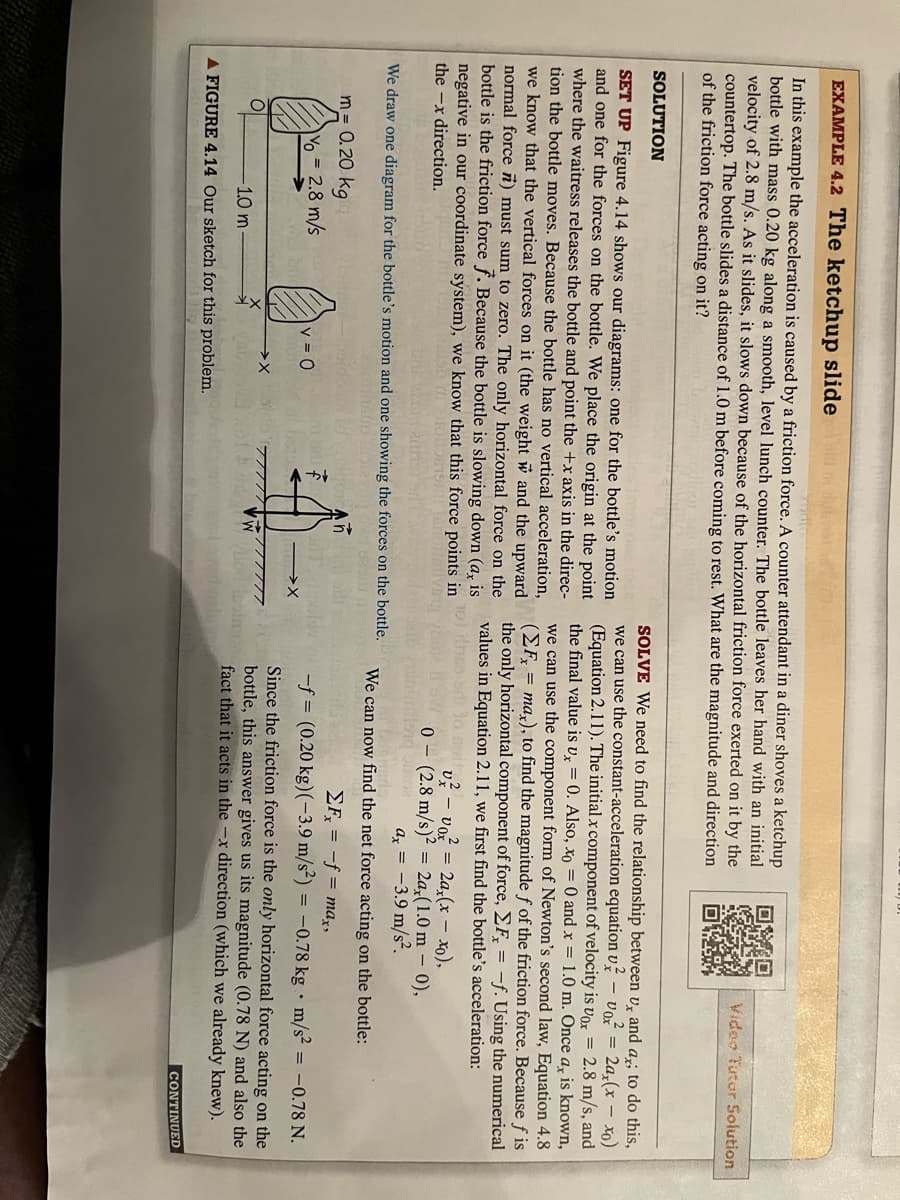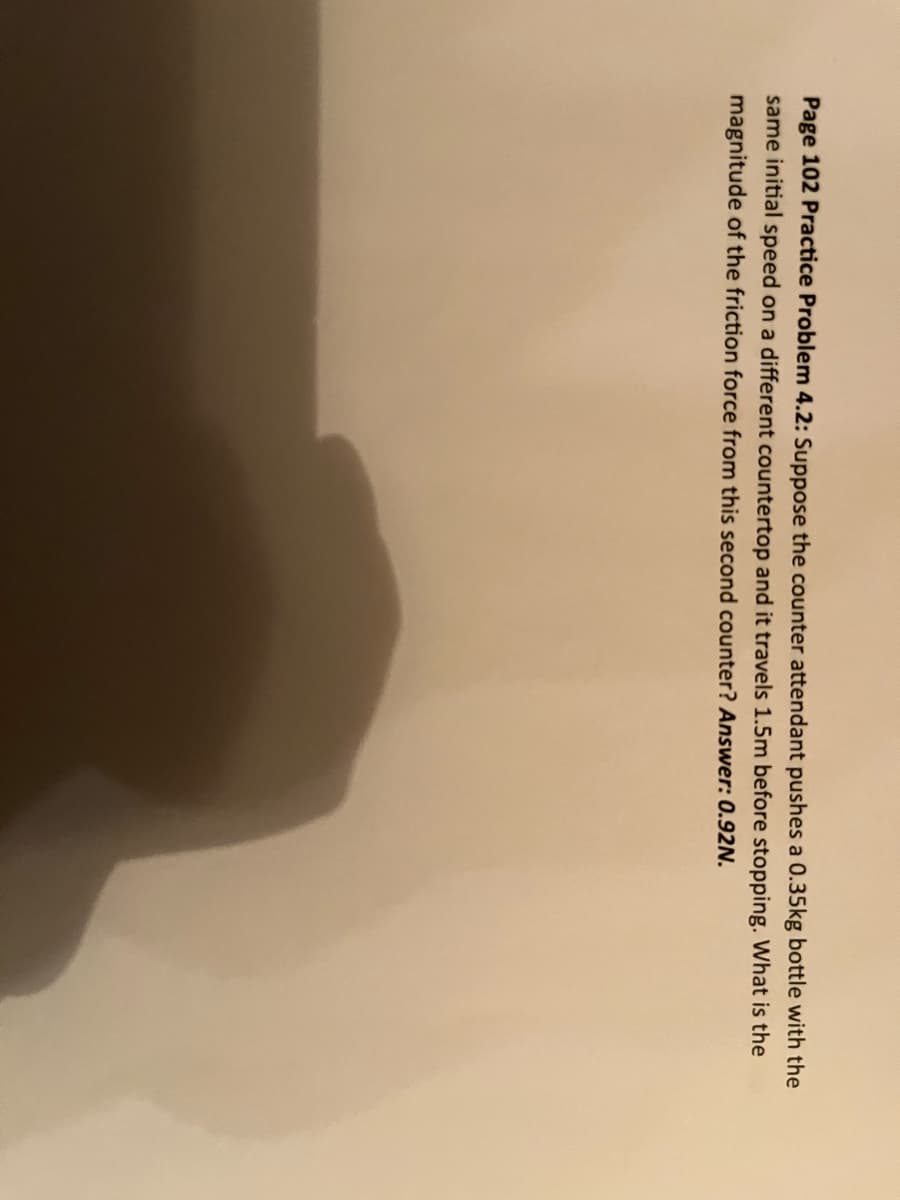Page 102 Practice Problem 4.2: Suppose the counter attendant pushes a 0.35kg bottle with the same initial speed on a different countertop and it travels 1.5m before stopping. What is the magnitude of the friction force from this second counter? Answer: 0.92N.
Page 102 Practice Problem 4.2: Suppose the counter attendant pushes a 0.35kg bottle with the same initial speed on a different countertop and it travels 1.5m before stopping. What is the magnitude of the friction force from this second counter? Answer: 0.92N.
Related questions
Question
The second photo has background info to help solve the practice problem

Transcribed Image Text:EXAMPLE 4.2 The ketchup slide bir
In this example the acceleration is caused by a friction force. A counter attendant in a diner shoves a ketchup
bottle with mass 0.20 kg along a smooth, level lunch counter. The bottle leaves her hand with an initial
velocity of 2.8 m/s. As it slides, it slows down because of the horizontal friction force exerted on it by the
countertop. The bottle slides a distance of 1.0 m before coming to rest. What are the magnitude and direction
of the friction force acting on it?
SOLUTION
SET UP Figure 4.14 shows our diagrams: one for the bottle's motion
and one for the forces on the bottle. We place the origin at the point
where the waitress releases the bottle and point the +x axis in the direc-
tion the bottle moves. Because the bottle has no vertical acceleration,
we know that the vertical forces on it (the weight and the upward
normal force ) must sum to zero. The only horizontal force on the
bottle is the friction force f. Because the bottle is slowing down (a, is
negative in our coordinate system), we know that this force points in
the x direction.
We draw one diagram for the bottle's motion and one showing the forces on the bottle.
stroncan
m= 0.20 kg
O
Yo = 2.8 m/s
|v=0
-1.0 m
A FIGURE 4.14 Our sketch for this problem.
-X
77777777777
Bo
SOLVE We need to find the relationship between u, and a,; to do this,
we can use the constant-acceleration equation v voz = 2ax(x - xo)
(Equation 2.11). The initial x component of velocity is Vox = 2.8 m/s, and
the final value is ux = 0. Also, xo = 0 and x = 1.0 m. Once a, is known,
we can use the component form of Newton's second law, Equation 4.8
(EF, = max), to find the magnitude f of the friction force. Because fis
the only horizontal component of force, Fx = -f. Using the numerical
values in Equation 2.11, we first find the bottle's acceleration:
Video Tutor Solution
v² - voz = 2a,(x - xo),
0 (2.8 m/s)² = 2a,(1.0m - 0),
ax = -3.9 m/s².
We can now find the net force acting on the bottle:
ΣFx = -f= max,
-f= (0.20 kg) (-3.9 m/s²) -0.78 kg m/s² = -0.78 N.
Since the friction force is the only horizontal force acting on the
bottle, this answer gives us its magnitude (0.78 N) and also the
fact that it acts in the -x direction (which we already knew).
.
CONTINUED

Transcribed Image Text:Page 102 Practice Problem 4.2: Suppose the counter attendant pushes a 0.35kg bottle with the
same initial speed on a different countertop and it travels 1.5m before stopping. What is the
magnitude of the friction force from this second counter? Answer: 0.92N.
Expert Solution
This question has been solved!
Explore an expertly crafted, step-by-step solution for a thorough understanding of key concepts.
This is a popular solution!
Trending now
This is a popular solution!
Step by step
Solved in 2 steps
